It took a while, but now Armytek continued their Partner series: Let’s have a look at their “new” Partner C2, a tactical flashlight with surprising throw and magnetic charging. This model was slowly released over a couple of months and finally arrived in Germany a few weeks ago.
You can find the German version of this review on my website: SammysHP Blog › Armytek Partner C2
The flashlight was provided by the manufacturer for this review. Thank you very much!

Supplied parts and hardware
- 18650 Li-ion battery with 3200 mAh (3.55 V at arrival)
- Magnetic charger
- Lanyard
- Clip
- Holster
- 2x replacement o-ring
- Quick start guide (EN, DE, FR, RU, FI, SE, NO, PL)
In the past there was a QR code in the quick start guide which linked to a PDF of a comprehensive manual with all details. Unfortunately this isn’t available so far. On the other hand the operation of the Partner C2 is so simple, that you won’t need more than the quick start guide to use it.
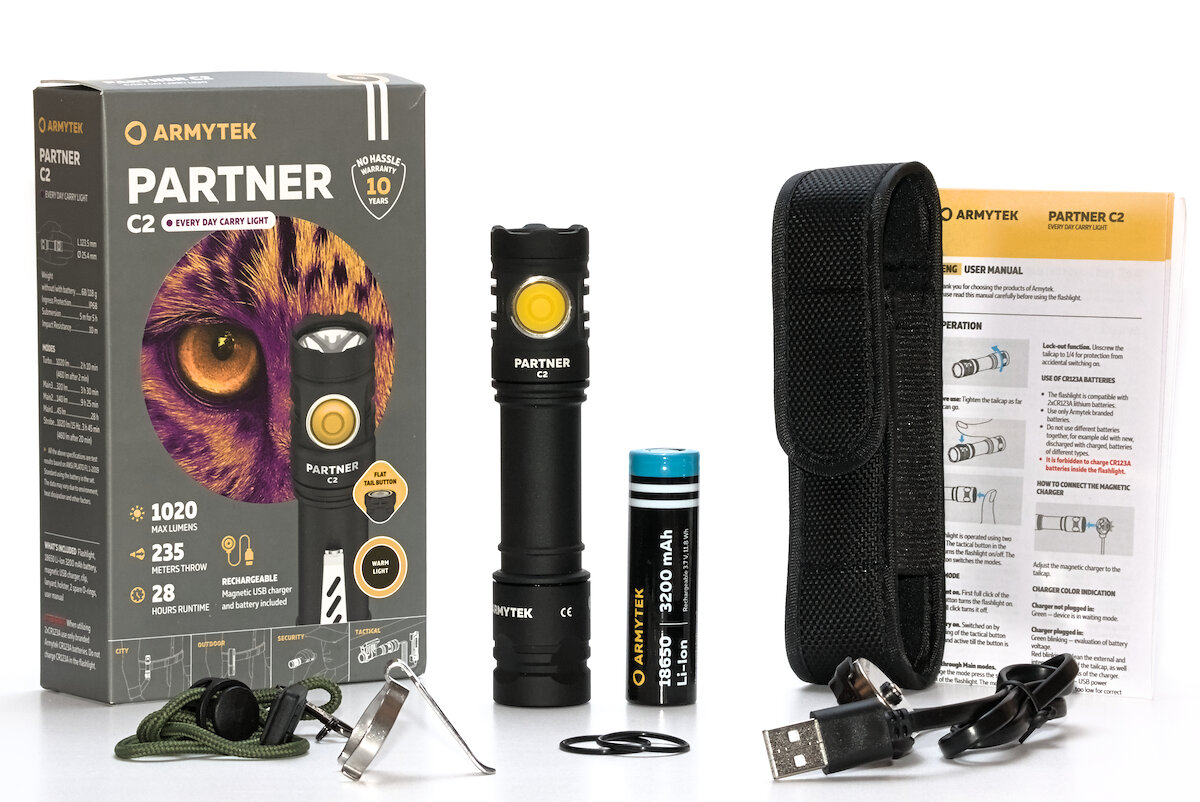
Size and weight is somewhere in the middle of all Armytek flashlights. Of course there are smaller 18650 flashlights, but I think this is a decent size for a tactical flashlight. Pocketability is less important than easy and reliable handling, for example with gloves in difficult situations.
Length: 123.4 m
Diameter (head): 25.4 mm
Diameter (battery tube): 21.0 mm
Diameter (tailcap): 25.4 mm
Weight (without battery): 69.6 g
Weight (18650 battery): 45.4 g
Weight (total): 115.0 g
All of the following flashlights use a 18650 battery, except for the Prime C2 Pro Max which has a 21700 battery.
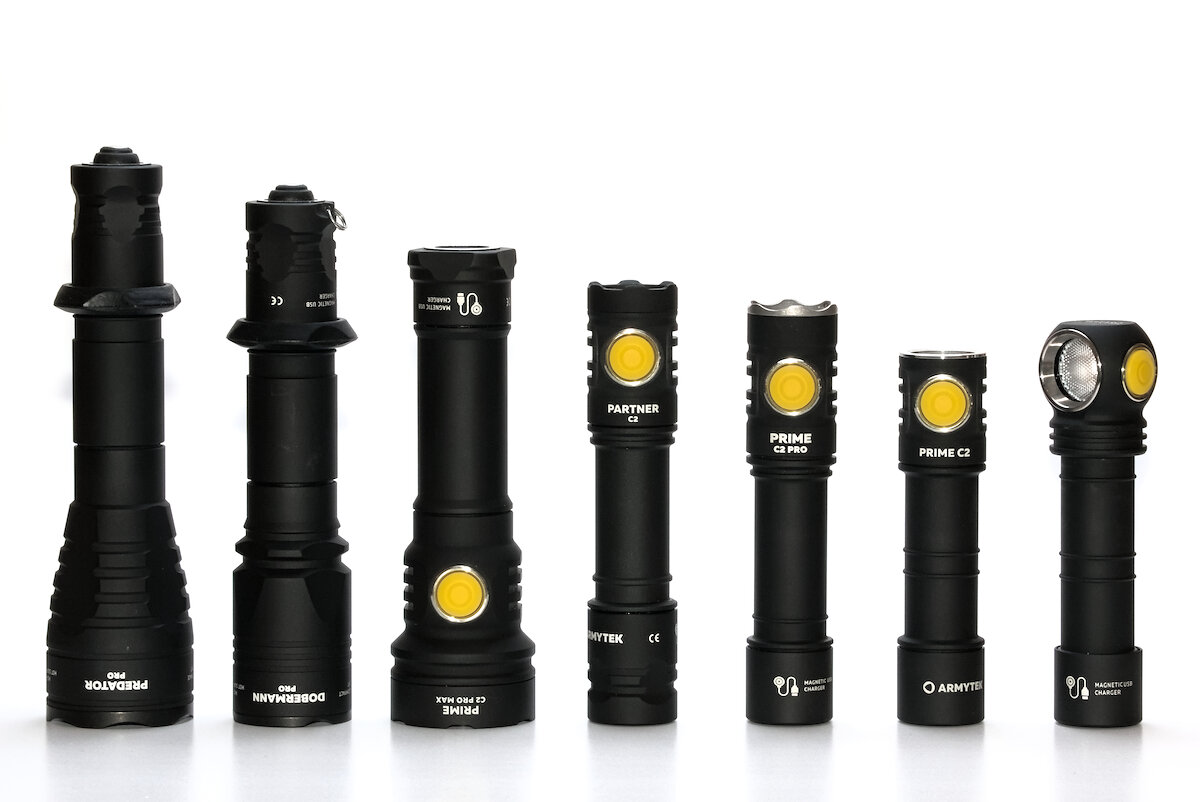
The rough anodization allows for a secure handling even without knurling, but makes it harder to clean. It’s almost like a chalkboard.
A clip can be attached to the battery tube, right at the thin ring which stops it from sliding. The supplied clip is very stiff and will damage the anodization. When you start using it as a proper tactical flashlight, it shouldn’t matter. Looks like there were plans to allow the clip to sit at the head, but it doesn’t fit.

The protruding side switch does a good job at preventing the flashlight from rolling away on a flat surface. It is only used to change the brightness, so accidental activation isn’t possible.
The black bezel has minimal crenelation, just enough to be able to see if it is turned on when standing on its head.
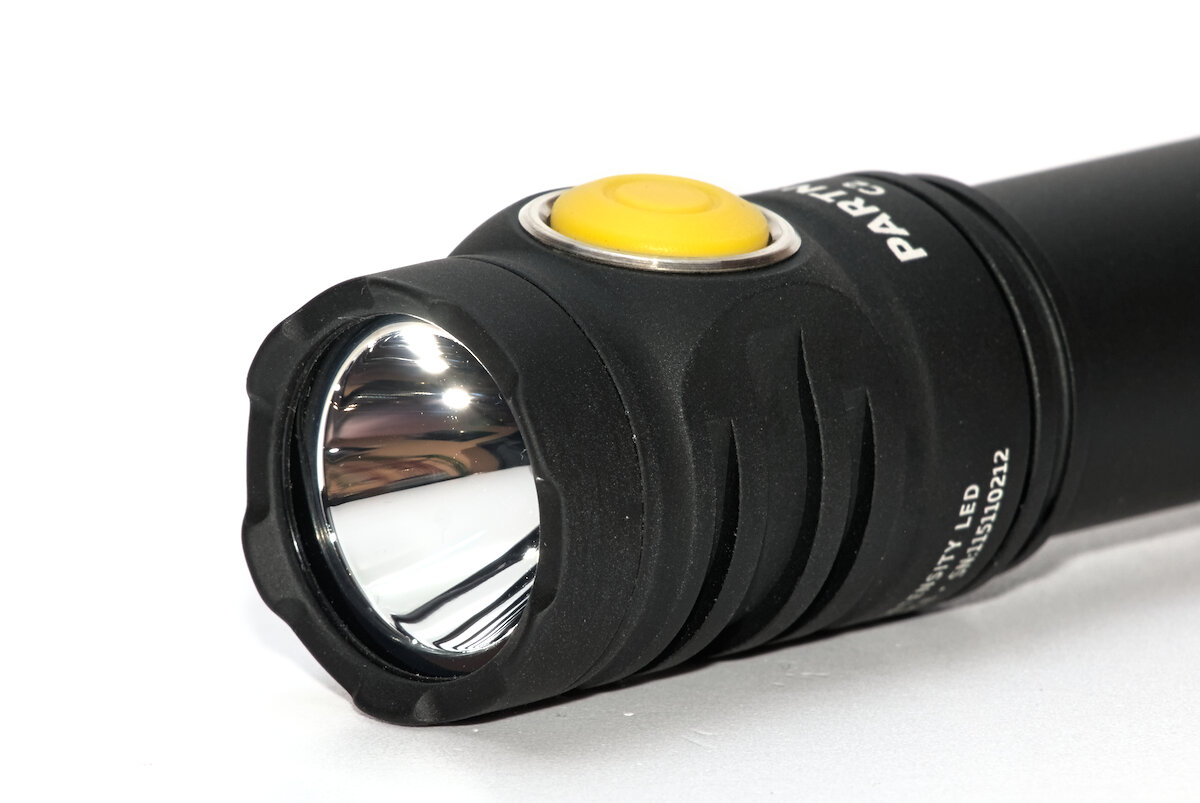
For storage or carrying it comes with a nice holster which is closed with Velcro. It can be attached either with a closed loop or with a D-ring.

The lanyard hole on the tailcap is… special. The diameter of the hole is only 1.5 mm and it has a wall thickness of only 0.4 mm.

The contacts on the tailcap make it possible to charge the battery inside the flashlight. A very good system to make it more robust against water and dirt compared to a USB port, but it requires the special magnetic charger. Just bring the charger close to the contacts and it will snap in place automatically. It is not necessary to loosen the tailcap like with other Armytek flashlights (and it would prevent charging).
LEDs in the charger tell you the current charging status. Neat: After 30 seconds the LEDs will slowly fade to a low level to be less annoying in the dark.
| Color | Meaning |
|---|---|
| green | standby / charging finished |
| red blinking | dirty contacts |
| orange blinking | input voltage too low or dirty contacts |
| red | charging (1 A) |
| orange | charging with reduced current (0.5 A) |
Charging is started only when the battery voltage is below 4 V. Otherwise the green LED indicates a full battery. During charging the flashlight cannot be used.
The same charger is used for most other Armytek flashlights as well. Only the large tactical flashlights (Dobermann, Predator, Viking) use a different model. The new tailcap of the Partner C2 is compatible with those flashlights, which allows you to use all Armytek flashlights with the same charger!
It charges with up to 1.2 A in a very special way (example of the Prime C2). Instead of the common CC/CV method it charges mostly with constant current only. Every now and then the charging is interrupted for a short moment, maybe to measure the open circuit voltage. From my knowledge this isn’t a recommended way of charging Li-ion batteries and it could shorten the battery life.

Although the tailcap is slightly magnetic, it is not enough to hold the flashlight reliably. It barely holds it upside down.
Two o-rings in the tailcap protect it against water. It is rated for five hours at five meters depth under water (IPX8). It has also an impact resistance of 10 m. Tightening the tailcap takes 4½ turns.
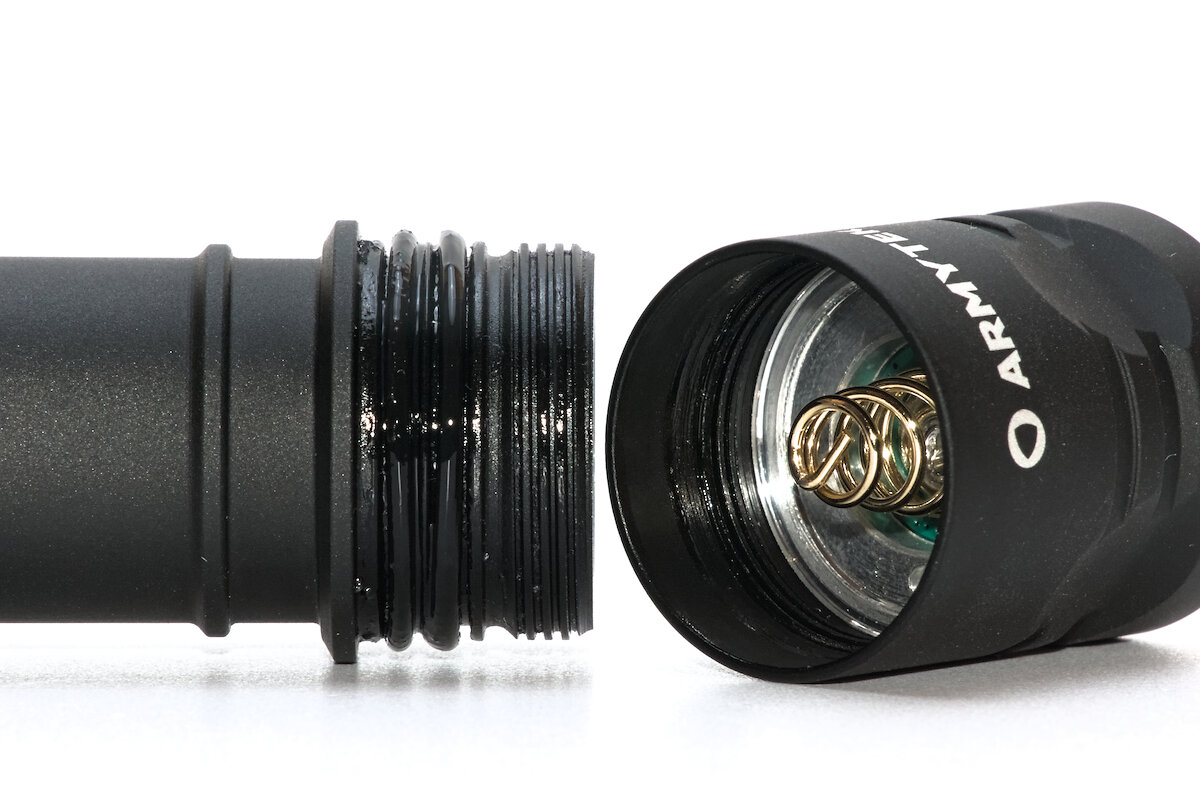
The battery tube is glued to the head. Both sides have strong springs to allow good contact and better protection against impacts. It supports flat and button top 18650 batteries, but protected batteries might be too long. Alternatively you can use two CR123A in series.

Overall the manufacturing quality is awesome. Only some edges like the cooling fins or the ring of the charging contact are a bit sharp.
User interface and features
The Partner C2 has an electronic tail switch that behaves like a forward clicky. A half press gives you momentary light, while a full press toggles the light on and off.

Actuation of the switch is almost silent, but you can still feel a subtle click. It feels very nice, but requires a surprising amount of force. Half press needs about 1500 g and a full press even 2300 g! From my experience 800 g is more common for an e-switch.
On the other hand the high force makes accidental activation in your pocket very unlikely. In addition it is slightly recessed, even more secure. If want to go a step further, you can loosen the tailcap for a mechanical lockout.

Pressing the yellow side switch advances the brightness. A short press switches through Main 1, Main 2 and Main 3. A long press activates turbo. All levels are memorized when you turn off the flashlight and are available for momentary activation.
There is just one more mode next to the four levels of brightness: a 16 Hz strobe. Hold the side switch while turning on the flashlight to add (or remove) it from the rotation. It is memorized as well.
I like this simple UI for a simple tool. It is impossible to get lost, just use it. On the other hand I would like to see direct access to the lowest level by holding the side switch when turning on the flashlight, similar to many other flashlights. No need for the strobe, which is pretty useless without a shortcut anyway.
The switch includes a backlight that shows the approximate state of charge when the flashlight is on.
| Voltage | Color |
|---|---|
| > 3.45 V | green flash (every five seconds) |
| 3.15 – 3.45 V | yellow/orange flash (every five seconds) |
| 2.95 – 3.15 V | yellow/orange flash (every two seconds) |
| 2.86 – 2.95 V | red flash (every second) |
| < 2.85 V | flashlight turns off |
When the temperature rises due to high power, the switch indicated the temperature.
| Color | Temperature |
|---|---|
| 3x orange flash (every two seconds) | Warning, flashlight gets warm |
| 3x red flash (every second) | Too hot, output will be reduced |
With the easy to find tail switch, the Partner C2 is great to operate even in stressful situations. To reach the side switch, it might be necessary to change your grip depending on the size of your hand.



Illumination
After some not so great experiences with the light quality of some Armytek flashlights, I got surprised by the Partner C2 in a very positive way. It has a Cree XP-L HI (the new one with flip chip technology). You can choose between a cool white and a warm white model. Of course I decided to test the warm white version.

The smooth reflector creates a very intense, small spot. There’s still enough light left for the spill to make it usable at short distances. The slightly yellow corona lets the spot appear a bit colder, but overall the color is homogeneous and pretty nice. Outside of the spill you might notice a very faint greenish ring from the “green” AR coating of the lens.


With the intense spot the Partner C2 manages to throw up to 235 m (ANSI FL1, according to the specs). That’s less than the Dobermann Pro, but in practice the difference is less noticeable.


Driver and runtime
Armytek was conservative with the maximum output, so that even the turbo works for a good time before stepping down. Runtime length from the manufacturer mostly matches my measurements.
| Mode | Brightness¹ | Runtime¹ | Intensity¹ (Throw²) | Current³ |
|---|---|---|---|---|
| Turbo | 1020 lm / 460 lm | 2 min + 2:08 h | 13806 cd (235 m) | 3.30 – 4.30 A |
| Main 3 | 320 lm | 3:20 h | 0.84 A | |
| Main 2 | 140 lm | 9:25 h | 0.34 A | |
| Main 3 | 45 lm | 28 h | 0.13 A |
¹ According to manufacturer ² ANSI FL1 ³ Measured
After almost three minutes the head reached a temperature of 50 °C and the flashlight started to reduce the output. Afterwards the temperature stabilized at 33 °C. The second highest level “Main 3” reached 29 °C.
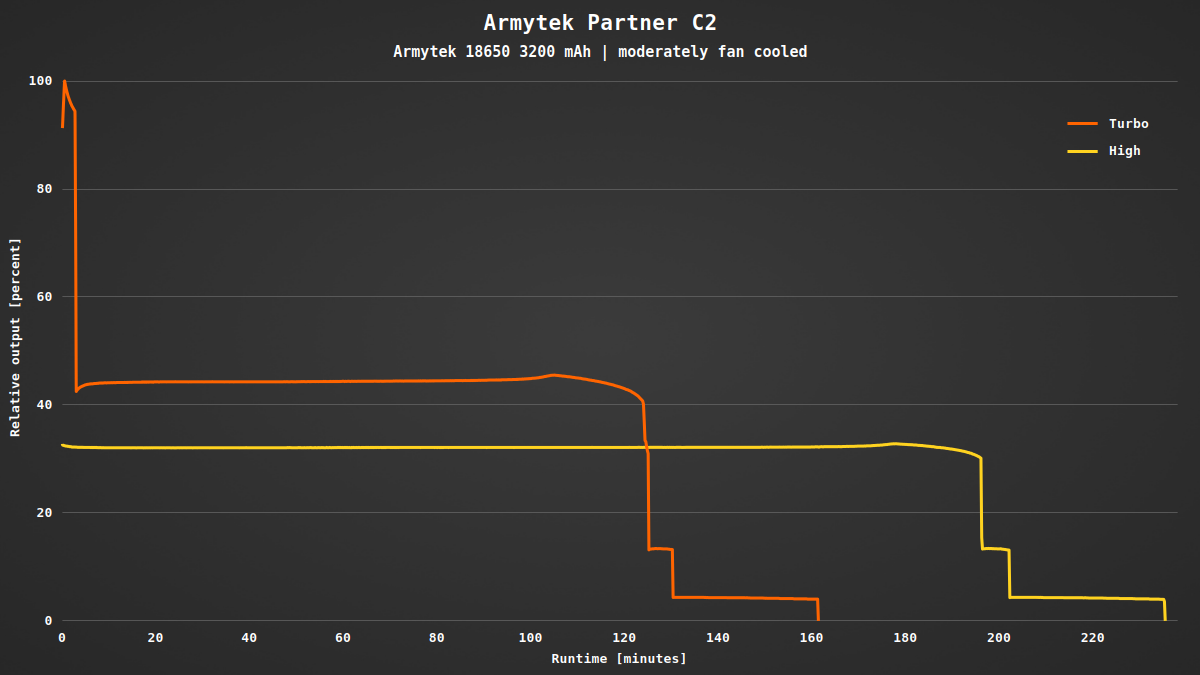

The constant current driver regulates the brightness without PWM. With an oscilloscope I was able to measure a minimal ripple of 30 kHz, which is perfectly fine and invisible.

I’m particularly amazed by the engineering of the tail switch. It works like a regular forward clicky, but it is entirely emulated by an electronic circuit: a (rather powerful) PIC microcontroller, together with its own energy harvesting circuit, two PCBs, various custom parts, all sandwiched with springs in a plastic cage.

This complex constructions allows almost silent operation, magnetic charging without loosening the tailcap and it prevents short circuit from the charging contacts. You find the identical circuit in the tailcap of the Dobermann or Predator, just with a different button. They also have the same threads and are completely interchangeable. This makes it possible to use the Dobermann or Predator with the more common magnetic charger from Armytek.
Conclusion
I’ve been waiting for this flashlight for a long time: At first glance the Armytek Partner C2 seems unspectacular, but in practice it turns out to be a reliable and easy to use partner in demanding situations. The electronic, two-stage tail switch gives you momentary light, silent operation and also serves as a magnetic charging port. The intense spot achieves a surprising amount of throw.
Instead of the strobe I would have preferred direct access to the lowest level. The flashlight can only be switched on in the last used brightness. Overall, an even lower brightness level would have been nice.
Got curious? You can get the Armytek Partner C2 in the cool white and the warm white version at armytek.com. The code “SAMMYSHP15” gives you a 15% discount.